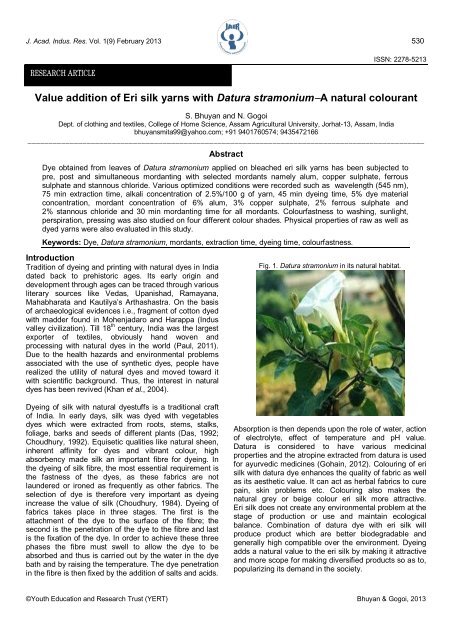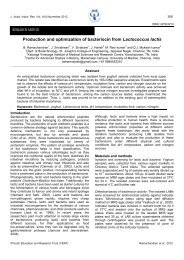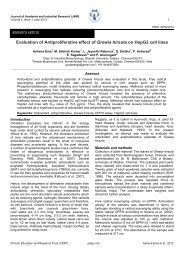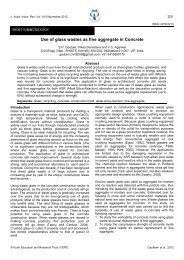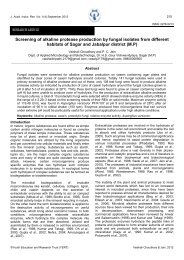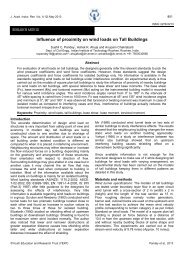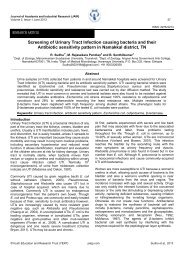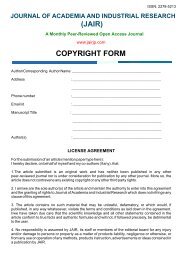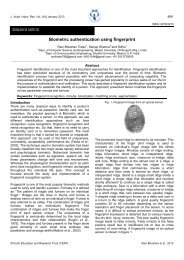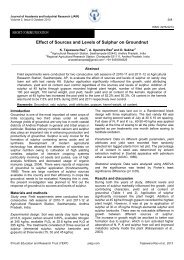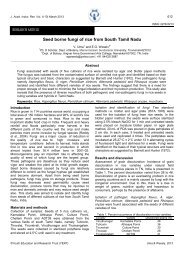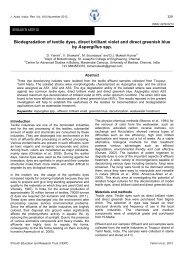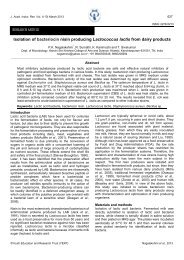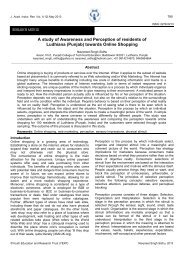Value addition of Eri silk yarns with Datura stramonium-A natural ...
Value addition of Eri silk yarns with Datura stramonium-A natural ...
Value addition of Eri silk yarns with Datura stramonium-A natural ...
Create successful ePaper yourself
Turn your PDF publications into a flip-book with our unique Google optimized e-Paper software.
J. Acad. Indus. Res. Vol. 1(9) February 2013 530RESEARCH ARTICLEISSN: 2278-5213<strong>Value</strong> <strong>addition</strong> <strong>of</strong> <strong>Eri</strong> <strong>silk</strong> <strong>yarns</strong> <strong>with</strong> <strong>Datura</strong> <strong>stramonium</strong>A <strong>natural</strong> colourantS. Bhuyan and N. GogoiDept. <strong>of</strong> clothing and textiles, College <strong>of</strong> Home Science, Assam Agricultural University, Jorhat-13, Assam, Indiabhuyansmita99@yahoo.com; +91 9401760574; 9435472166______________________________________________________________________________________________AbstractDye obtained from leaves <strong>of</strong> <strong>Datura</strong> <strong>stramonium</strong> applied on bleached eri <strong>silk</strong> <strong>yarns</strong> has been subjected topre, post and simultaneous mordanting <strong>with</strong> selected mordants namely alum, copper sulphate, ferroussulphate and stannous chloride. Various optimized conditions were recorded such as wavelength (545 nm),75 min extraction time, alkali concentration <strong>of</strong> 2.5%/100 g <strong>of</strong> yarn, 45 min dyeing time, 5% dye materialconcentration, mordant concentration <strong>of</strong> 6% alum, 3% copper sulphate, 2% ferrous sulphate and2% stannous chloride and 30 min mordanting time for all mordants. Colourfastness to washing, sunlight,perspiration, pressing was also studied on four different colour shades. Physical properties <strong>of</strong> raw as well asdyed <strong>yarns</strong> were also evaluated in this study.Keywords: Dye, <strong>Datura</strong> <strong>stramonium</strong>, mordants, extraction time, dyeing time, colourfastness.IntroductionTradition <strong>of</strong> dyeing and printing <strong>with</strong> <strong>natural</strong> dyes in Indiadated back to prehistoric ages. Its early origin anddevelopment through ages can be traced through variousliterary sources like Vedas, Upanishad, Ramayana,Mahabharata and Kautilya’s Arthashastra. On the basis<strong>of</strong> archaeological evidences i.e., fragment <strong>of</strong> cotton dyed<strong>with</strong> madder found in Mohenjadaro and Harappa (Indusvalley civilization). Till 18 th century, India was the largestexporter <strong>of</strong> textiles, obviously hand woven andprocessing <strong>with</strong> <strong>natural</strong> dyes in the world (Paul, 2011).Due to the health hazards and environmental problemsassociated <strong>with</strong> the use <strong>of</strong> synthetic dyes, people haverealized the utility <strong>of</strong> <strong>natural</strong> dyes and moved toward it<strong>with</strong> scientific background. Thus, the interest in <strong>natural</strong>dyes has been revived (Khan et al., 2004).Dyeing <strong>of</strong> <strong>silk</strong> <strong>with</strong> <strong>natural</strong> dyestuffs is a traditional craft<strong>of</strong> India. In early days, <strong>silk</strong> was dyed <strong>with</strong> vegetablesdyes which were extracted from roots, stems, stalks,foliage, barks and seeds <strong>of</strong> different plants (Das, 1992;Choudhury, 1992). Equisetic qualities like <strong>natural</strong> sheen,inherent affinity for dyes and vibrant colour, highabsorbency made <strong>silk</strong> an important fibre for dyeing. Inthe dyeing <strong>of</strong> <strong>silk</strong> fibre, the most essential requirement isthe fastness <strong>of</strong> the dyes, as these fabrics are notlaundered or ironed as frequently as other fabrics. Theselection <strong>of</strong> dye is therefore very important as dyeingincrease the value <strong>of</strong> <strong>silk</strong> (Choudhury, 1984). Dyeing <strong>of</strong>fabrics takes place in three stages. The first is theattachment <strong>of</strong> the dye to the surface <strong>of</strong> the fibre; thesecond is the penetration <strong>of</strong> the dye to the fibre and lastis the fixation <strong>of</strong> the dye. In order to achieve these threephases the fibre must swell to allow the dye to beabsorbed and thus is carried out by the water in the dyebath and by raising the temperature. The dye penetrationin the fibre is then fixed by the <strong>addition</strong> <strong>of</strong> salts and acids.Fig. 1. <strong>Datura</strong> <strong>stramonium</strong> in its <strong>natural</strong> habitat.Absorption is then depends upon the role <strong>of</strong> water, action<strong>of</strong> electrolyte, effect <strong>of</strong> temperature and pH value.<strong>Datura</strong> is considered to have various medicinalproperties and the atropine extracted from datura is usedfor ayurvedic medicines (Gohain, 2012). Colouring <strong>of</strong> eri<strong>silk</strong> <strong>with</strong> datura dye enhances the quality <strong>of</strong> fabric as wellas its aesthetic value. It can act as herbal fabrics to curepain, skin problems etc. Colouring also makes the<strong>natural</strong> grey or beige colour eri <strong>silk</strong> more attractive.<strong>Eri</strong> <strong>silk</strong> does not create any environmental problem at thestage <strong>of</strong> production or use and maintain ecologicalbalance. Combination <strong>of</strong> datura dye <strong>with</strong> eri <strong>silk</strong> willproduce product which are better biodegradable andgenerally high compatible over the environment. Dyeingadds a <strong>natural</strong> value to the eri <strong>silk</strong> by making it attractiveand more scope for making diversified products so as to,popularizing its demand in the society.©Youth Education and Research Trust (YERT) Bhuyan & Gogoi, 2013
J. Acad. Indus. Res. Vol. 1(9) February 2013 531Considering the importance <strong>of</strong> marketability, eco-friendlydyeing and vast potentiality <strong>of</strong> eri <strong>silk</strong>, it was decided tocarry out an investigation <strong>with</strong> the following objectives.1. To optimize the dyeing condition <strong>of</strong> selected dye on eri<strong>silk</strong> <strong>yarns</strong>.2. To evaluate the colourfastness properties <strong>of</strong> dyed <strong>yarns</strong>.3. To study the physical properties <strong>of</strong> dyed <strong>yarns</strong>.Fig. 2. Yarns dyed <strong>with</strong> <strong>Datura</strong> <strong>stramonium</strong> dye.Materials and methodsCollection <strong>of</strong> leaves and dye extraction: <strong>Datura</strong><strong>stramonium</strong> leaves were collected from AssamAgricultural University campus and were washed <strong>with</strong>running tap water and grinned well to extract the dye(Fig. 1). <strong>Eri</strong> <strong>silk</strong> <strong>yarns</strong> collected from Lakhimpur districtwere degummed and bleached before dyeing. The dyeliquor was scanned using spectrophotometer between500-570 nm as it is the wavelength for green colour(Gohl and Vilensky, 1983).Optimization <strong>of</strong> parameters: Various dyeing conditionswere optimized such as alkali concentration, extractionmedium, dye extraction time, dye material concentration,mordanting concentration and time and mordantingmethods by calculating the dye absorption percentage byusing the formulae.OD <strong>of</strong> the liquor before dyeing OD <strong>of</strong> the liquor after dyeing% <strong>of</strong> dye = x 100absorptionOD <strong>of</strong> the liquor before dyeingEvaluation <strong>of</strong> colour fastness and physical properties:Colourfastnesss properties like colour fastness towashing <strong>of</strong> dyed eri <strong>silk</strong> <strong>yarns</strong> were tested by usingsasmira launder-o-mete. The wash fastness rating wasrated by using grey scale rating from 1-6. Colourfastnessto pressing (dry and wet) was done by subjecting the<strong>yarns</strong> to hot iron in both wet and dry condition andcompared <strong>with</strong> the grey scale to see the both colourchange and colour stain. Colourfastness to sunlight wasseen by exposing the <strong>yarns</strong> to the direct effect <strong>of</strong> sunlightsimultaneously from 9 am to 5 pm. Colourfastness toperspiration (acidic and alkali) was assessed by using,American Society for Testing Materials (1968) method.The test specimen <strong>of</strong> coloured textiles were wet out inalkali and acidic perspiration solution <strong>with</strong> fixedmechanical pressure and allowed to dry slowly at aslightly elevated temperature. Physical properties suchas count <strong>with</strong> the help <strong>of</strong> Bessley balance, tenacity andelongation using Instron strength tester, density, Wickingheight and moisture content by using hot air oven.Tenacity and strenght were evaluated by subjecting toanalysis <strong>of</strong> variance through completely randomiseddesign by using` F’ test.Results and discussionThe wavelength <strong>of</strong> the dye was found to be 545 nm.Alkaline medium was selected as the best medium fordye extraction. Bansal etal (2006) also found alkalimedium as best medium on dyeing <strong>of</strong> <strong>silk</strong>en <strong>yarns</strong> <strong>with</strong>berberry dye.a. Original; b. Without mordant (Light yellow green colour);c. Alum mordanted (Light green colour); d. Copper sulphate mordanted(Camouflage green colour); e. Ferrous sulphate mordanted (Brownishgreen colour); f. Stannous chloride mordanted (Lime colour).Alkali concentration 2.5%/100 g <strong>of</strong> yarn showed highestabsorption value. The optimum dye concentration wasfound to be 5% similar to the findings <strong>of</strong> Phukan (2005)on dyeing <strong>silk</strong> <strong>yarns</strong> <strong>with</strong> heartwood <strong>of</strong> jackfruit.The dyeing time was optimized as 45 min similar to theresults shown by Bordoloi (2008) on dyeing eri <strong>silk</strong> <strong>yarns</strong><strong>with</strong> bark <strong>of</strong> carambola. The mordant concentration wasfound to be 6%/100 g <strong>of</strong> <strong>yarns</strong> for alum, 4%/100 g forcopper sulphate, 2%/100 g for both ferrous sulphate andstannous chloride. Dyeing time was found to be for30 min for all mordants, the optical density valuedecreased as the <strong>yarns</strong> were unable to absorb dye afterreaching the maximum absorption point. Simultaneousmordanting method was considered as the best methodfor alum, copper sulphate and ferrous sulphate whilepost mordanting method was best for stannous chloridemordanted samples. The colour obtained from daturadye on eri <strong>silk</strong> <strong>yarns</strong> were found to be light yellow green<strong>with</strong>out mordant, light green mordanted <strong>with</strong> alum,camouflage green when mordanted <strong>with</strong> coppersulphate, ferrous sulphate mordanted produce browncolour and lime colour obtained when mordanted <strong>with</strong>stannous chloride (Fig. 2).Copper sulphate mordanted sample showed good colourfastness and no colour staining. The alum mordantedsample showed good fastness to crocking, perspiration(alkali) and pressing (dry and wet) and very fair fastnessto washing and acidic perspiration while fair fastness tosunlight and slightly stained on acidic perspiration.Ferrous sulphate mordanted sample showed goodfastness to sunlight, dry crocking, acidic perspiration anddry pressing while very fair fastness to wet crocking, wetpressing and alkaline perspiration and slightly stained inwet pressing and wet crocking.©Youth Education and Research Trust (YERT) Bhuyan & Gogoi, 2013
J. Acad. Indus. Res. Vol. 1(9) February 2013 532MordantusedSunlightTable 1. Ratings for colourfastness properties <strong>of</strong> dyed samples.Crocking Perspiration PressingWashingDry Wet Acidic Alkaline Dry WetCC CS CC CS CC CS CC CS CC CS CC CS CC CSWithoutmordant3 4 5 5 5 4 4 4 4 5 5 5 5 5 5Alum 3 4 5 5 5 5 5 4 4 5 5 5 5 5 5Coppersulphate5 5 5 5 5 5 5 5 5 5 5 5 5 5 5Ferroussulphate5 4 5 5 5 4 4 5 5 4 4 5 5 4 4Stannouschloride3 4 5 5 5 5 5 4 4 5 5 5 5 5 5CC: Colour change; CS : Colour staining; CC Ratings: 1 = very poor, 2 = poor, 3 = fair, 4 = very fair, 5 = good, 6 = very good;CS Ratings: 1= heavily stained, 2= considerably stained, 3= noticeable stained, 4=slightly stained, 5= negligible or no staining.Stannous chloride mordanted sample showed goodfastness to dry and wet crocking, dry and wet pressingalkaline perspiration, very fair fastness to acidicperspiration and washing and fair fastness to sunlightwhile <strong>with</strong>out mordanted sample showed good fastnessdry and wet pressing, alkali perspiration and dry crockingwhile very fair fastness to washing, wet crocking andacidic perspiration while fair fastness to sunlight and itshowed slightly stained in wet crocking and acidicperspiration (Table 1). The count and twist <strong>of</strong> raw eri <strong>silk</strong><strong>yarns</strong> were found to be 14 and 11 TPI. The raw <strong>yarns</strong>showed a density <strong>of</strong> 1.98 g/cm 2 while decreased to1.54 g/cm 2 , 1.44, 1.34, 1.28 and 1.20 g/cm 2 formordanted samples <strong>with</strong> alum, copper sulphate, ferroussulphate, stannous chloride and <strong>with</strong>out mordantedsamples. The wicking height and moisture regain <strong>of</strong> dyed<strong>yarns</strong> increased than the raw <strong>yarns</strong> due to variouspre-treatment such as degumming, bleaching prior todyeing. Tenacity and elongation decreased in dyed <strong>yarns</strong>than undyed ones. Among the dyed <strong>yarns</strong>, alummordanted sample showed highest tenacity (1.92 g/tex)and elongation (21.9%), while copper sulphatemordanted samples showed lowest tenacity (1.66g/tex)and elongation (8.33%) (Table 2). The decrease intenacity might be due to break down <strong>of</strong> interfibre bondsand interfibre forces <strong>of</strong> attraction during dyeing andprocessing (Troatman, 1975).ConclusionDyeing <strong>of</strong> eri <strong>silk</strong> <strong>yarns</strong> <strong>with</strong> datura dye produces variouss<strong>of</strong>t and subtle <strong>natural</strong> shades. Sample mordanted <strong>with</strong>coper sulphate showed good fastness to sunlight,perspiration, pressing, washing and crocking. On theother hand, <strong>Datura</strong> <strong>stramonium</strong> plant has variousmedicinal properties. It is used to cure pains, boils,pimples, asthma, dandruff, piles etc (Agharkar, 1991).So, eri fabrics woven from dyed eri <strong>silk</strong> <strong>yarns</strong> <strong>with</strong> daturamay relieve body pains. Thus, dyeing eri <strong>silk</strong> <strong>yarns</strong> aswell as fabrics <strong>with</strong> D. <strong>stramonium</strong>) dye give a new lookto this poor man’s friend, will boost in preparingdiversified products. Such efforts are required to improvethe quality and aesthetic value <strong>of</strong> eri <strong>silk</strong> to match <strong>with</strong>new trends in national and international market.Table 2. Effect <strong>of</strong> dyeing on physical properties<strong>of</strong> dyed eri <strong>silk</strong> yarn.Dyed yarn sampleTenacity Elongation(g/tex) (%)Raw yarn 1.99 22.23Without mordant 1.71 19.87Alum mordanted 1.92 21.91Copper sulphate mordanted 1.66 18.33Ferrous sulphate mordanted 1.69 20.51Stannous chloride mordanted 1.79 20.93S.Ed. 0.008 0.010CD-5% 0.018 0.022Interaction between all the variables was statistically significant at 5%.AcknowledgmentsWe are thankful to the Head, department <strong>of</strong> clothing andtextiles, College <strong>of</strong> Home Science, Jorhat for providing allkinds <strong>of</strong> support and encouragement.References1. Agharkar, S.P. 1991. Medicinal plants. Bombay presidency.Scientific Publishers, Jodhpur (India). pp. 88-89.2. ASTM. 1968. Standard test methods for breaking load(strength) and elongation <strong>of</strong> yarn by single strand methods.Part 24, American Society for Testing Materials,Philadelphia. pp. 444-450.3. Bansal, A., Rani, S., Sharma, A. and Sood. A. 2006. Dyeing<strong>of</strong> <strong>silk</strong>en yarn <strong>with</strong> berberry dye. Tex. Trend. 67(12): 39-40.4. Bordoloi, M. 2008. Dyeing <strong>of</strong> eri <strong>silk</strong> yarn <strong>with</strong> bark <strong>of</strong>carambola (Averrhoa carambola), Master degree Thesis,Assam Agricultural University.5. Choudhury, S.N. 1982. <strong>Eri</strong> <strong>silk</strong> industry. Directorate <strong>of</strong>Sericulture and Weaving, Assam, Guwahati. pp.29-44.6. Choudhury, S.N. 1992. Silk and sericulture. Directorate <strong>of</strong>sericulture. Guwahati. pp.1-5.7. Das, S. 1992. Application <strong>of</strong> <strong>natural</strong> dye on <strong>silk</strong>. Colourage.39(9): 52-54.8. Gohain, A. 2012. Dhatura. Prantik. 31(13): 25.9. Gohl, E.P.G. and Vilensky, L.D. 1983. Textile science, 2 nded., Longman Cheshire Pvt. Ltd. pp.32-33.10. Phukan, R. 2005. Dyeing <strong>of</strong> <strong>silk</strong> yarn <strong>with</strong> the heartwood <strong>of</strong>jackfruit. Tex. Trend. 48(7): 33-35.11. Trotman, E.B. 1975. Dyeing and chemical technology <strong>of</strong>textiles fibers, 6 th ed., Griffin and Co., London, pp.83-84.©Youth Education and Research Trust (YERT) Bhuyan & Gogoi, 2013


